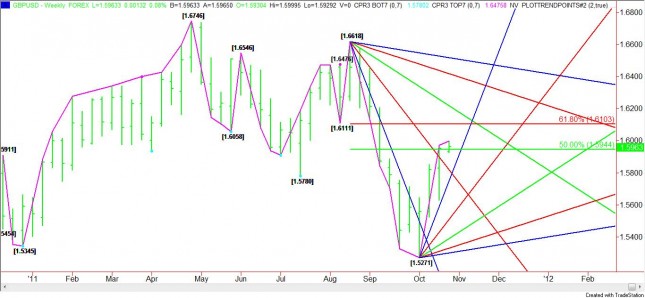GBP USD traders have to be asking themselves, is the Dollar trading weaker against the British Pound or is the Sterling gaining strength? Since bottoming at 1.5271, the GBP USD has retraced a little more than 50% of the break from the August top at 1.6618. Despite this impressive rally, the Sterling remains in a downtrend on the weekly chart. The move to the mid-point of the major range serves only as a sign that traders are not as bearish as the Pound/Dollar as they were a few weeks ago.
The flight to safety rally in the U.S. Dollar from mid-August to early October was the main reason for the weakness in the British Pound during that time period. Since the risk sentiment shift sent the Euro higher, the Dollar has lost ground, leading to the strong rise in the British Pound. This seems to be the obvious reason for the rally since the economic news has been bleak. Could it be that the British Pound is being treated as a safe haven alternative to the Dollar, not unlike the Japanese Yen and the Swiss Franc? If this is true then the Sterling is likely to feel some heat when the Dollar turns around.
With the GBP USD currently trading inside of a key retracement zone at 1.5944 to 1.6103, what better place to begin a correction. Even if the top level is exceeded, Gann angle resistance at 1.6218 is likely to stop the rally.

Maybe some traders are assuming that the strength in the GBP USD means theU.K.economy is improving. This could not be further from the truth or the Bank of England would not have applied another round of quantitative easing earlier in the month. With the Federal Reserve easing its QE plans and the BoE refreshing, theU.S.economy is in more of a position to grow than theU.K.economy. This being said, bullish traders will have to be careful at current price levels so that they are not caught in a bull-trap.
This may take place this week if the GBP USD suddenly surges as good news is released from the Euro Zone. A euphoric reaction may take place initially, however, once the initial reaction wears off, traders are likely to look at the fundamentals and decide that it’s time to sell the British Pound.
Technically, traders should watch for either a daily or weekly closing price reversal this week to signal the end of the current rally. This will occur when the GBP USD produces a higher-high than the previous day or week and closes lower. Bullish traders may have been given a free pass for the next three days since the first Euro Zone deadline passed, but as Wednesday’s new deadline approaches, look for more volatility and a possible turnaround in the British Pound.
Find out more about
GBP/USD.